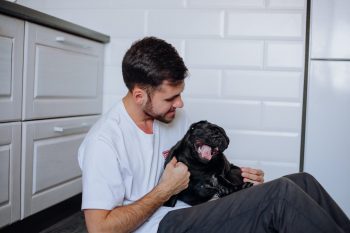The Pug, with its distinctive face and charming personality, is a breed that has captured the hearts of many dog lovers. Known for their sociable and affectionate nature, Pugs are often considered ideal pets for various living environments, including apartments. This article will delve into the specifics of raising a Pug in an apartment setting, covering their temperament, exercise needs, space requirements, grooming needs, and overall care.
1. Understanding the Pug Temperament
Pugs are known for their friendly and loving nature. They thrive on human companionship and are known for being particularly good with children and other pets. This breed is characterized by its playful yet calm demeanor, making them well-suited to apartment living. Pugs are also known for their tendency to be quite vocal, which includes grunting and snoring, due to their brachycephalic (flat-faced) nature. While they generally aren’t known for excessive barking, their unique sounds are something potential apartment dwellers should be aware of.
2. Exercise Needs of Pugs
Pugs require moderate exercise to maintain their health and happiness. They are not as high-energy as some other breeds, making them suitable for apartment living. Short daily walks and indoor play sessions are typically sufficient to meet their exercise needs. However, due to their brachycephalic nature, it is important to avoid strenuous exercise, especially in hot or humid weather, as they are prone to breathing difficulties.
3. Space Requirements for Pugs
One of the advantages of Pugs is that they do not require a large living space. Their small size makes them ideal for apartment living. They need their own space for a bed, food, and water bowls, and some toys, but they don’t require a large area to be happy. Pugs are also relatively inactive indoors, often preferring to snuggle up next to their owner over playing.
4. Grooming and Care
Pugs have a short coat that sheds quite a bit, despite its length. Regular grooming, including brushing a few times a week, is required to manage shedding. They also require special care for their facial wrinkles, which need to be cleaned regularly to prevent infection. In an apartment setting, regular grooming is important to manage shedding and keep the living space clean.
5. Health Considerations in Apartments
Pugs are prone to certain health issues, including respiratory problems, obesity, and skin allergies. Their flat faces can cause breathing difficulties, which is an important consideration in an apartment, especially in warmer climates or apartments without good air conditioning. Keeping a Pug at a healthy weight is also crucial, as obesity can exacerbate health issues.
6. Socialization and Behavior in Apartment Living
Socialization is important for Pugs, especially in an apartment setting where they may encounter many neighbors and other animals. Exposure to different people, animals, and environments is key to ensuring they are well-behaved and sociable. Pugs are generally friendly but should be socialized from a young age to ensure they are comfortable in various situations.
7. Managing Noise and Barking
While Pugs are not known for excessive barking, they can become vocal in response to certain stimuli or when seeking attention. Training and providing adequate attention and mental stimulation can help manage any potential noise issues in an apartment setting.
8. Considerations for Shared Spaces
In apartment living, it’s important to be considerate of neighbors when it comes to pet ownership. Training your Pug to behave well in communal areas, such as not jumping on neighbors or barking in hallways, is important. Regular walks and social interactions can help keep your Pug well-behaved in shared spaces.
9. Dealing with Separation Anxiety
Pugs are known for their attachment to their owners and can suffer from separation anxiety. This can be a concern in apartments where distressed behavior, such as barking or destructive actions, may disturb neighbors. Crate training, leaving them with toys, and gradually getting them used to being alone can help in managing separation anxiety.
10. Exercise and Play in Urban Settings
For apartment dwellers, providing sufficient exercise and playtime for a Pug requires creativity. Utilizing nearby parks for walks, engaging in indoor play, and socializing with other dogs in safe, controlled environments are great ways to ensure your Pug stays active and happy.
Conclusion
In conclusion, Pugs can certainly live and thrive in an apartment setting. Their small size, moderate exercise needs, and affectionate nature make them well-suited to this type of living environment. However, potential and current Pug owners should be mindful of their specific needs, including regular grooming, managing health concerns, and providing sufficient socialization and mental stimulation. With proper care and attention, a Pug can be a delightful companion in an apartment home.
Frequently Asked Questions An Apartment Owner Might Ask Before Getting A Pug
The post Can a Pug Live in An Apartment? appeared first on iHeartDogs.com.

